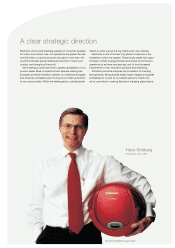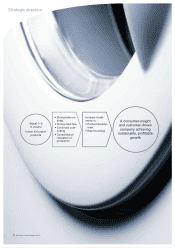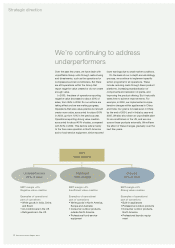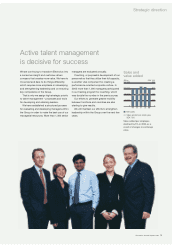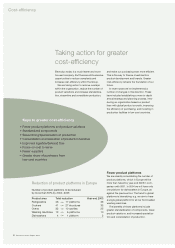Electrolux 2003 Annual Report Download - page 9
Download and view the complete annual report
Please find page 9 of the 2003 Electrolux annual report below. You can navigate through the pages in the report by either clicking on the pages listed below, or by using the keyword search tool below to find specific information within the annual report.
Electrolux Annual Report 2003 7
More efficient purchasing
In 2003 the Group spent about SEK 90
billion on purchases of materials and
services. Direct materials, including
components, accounted for about two
thirds of total purchases. In recent
years we have succeeded in steadily
reducing our annual purchasing costs.
In the coming years we expect to
obtain even greater savings, through
continued internal coordination and
consolidation, increased purchases
from Eastern Europe and Asia, and
standardization of components and
products.
Investments in Eastern Europe, Mexico and Asia
Increased
New plant in New plant in capacity in New plant in New plant in
Hungary Russia Poland Mexico Thailand
Product Refrigerators/ Washing Dryers Refrigerators Washing
freezers machines machines
Annual capacity 560,000 150,000 From 200,000 1,600,000 200,000
(Phase 1) to 800,000
Investment SEK 600m SEK 80m SEK 270m SEK 1,500m SEK 80m
Start of production 2005 2004 2006 2005 2003
Increased purchases
from low-cost countries
2003 2006
The goal is to increase the share of
purchases from low-cost countries
from about 20% today to about
40% in 2006.
40%
20%
Examples of regional production costs
Estimated landed cost for two different appliances
Relocating production facilities
The trend towards greater globalization of
products and markets creates opportunities
for shifting production to low-cost countries.
Building on our global structure, we’re expand-
ing our production base in Mexico, Eastern
Europe and Asia. The costs for relocation could
reach SEK 1–2 billion annually in the next few
years, which is in line with the Group’s previous
restructuring costs.
However, a major share of restructuring
costs in recent years was related to units that
are no longer part of the Group. The actions
that we are now taking are related directly to
our core businesses and should therefore make
a more positive contribution to profitability.
Western
Europe China Eastern
Europe
Washing machine
for EU market
Region of production
US China Mexico
Chest-freezer
for US market
Logistics
Direct Labor
& Overhead
Materials &
Components
Region of production
In the examples above, production in Mexico and Eastern
Europe is competitive with China and Korea.
Investment decisions in 2003 included two new plants in Eastern Europe, i.e. one in
Hungary for refrigerators and one in Russia for washing machines, as well as one
plant for washing machines in Thailand. We also decided to increase capacity at the
plant for dryers in Poland. In 2004, we decided to invest in a new plant for refrigerators
in Mexico.
The diagrams show the current total cost of
a chest-freezer sold in the US and a washing
machine sold in the EU. The cost of produc-
ing the chest-freezer in Mexico, including
purchases of materials and components from
low-cost countries, is fully competitive with
costs for a corresponding product produced
in Asia. Wages are higher in Mexico, but this
is offset by higher transport costs from Asia
to the US market. Cost relations are similar
for a washing machine produced in Eastern
Europe.
Cost-efficiency



